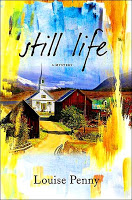 Part of the fun of taking part in a reading challenge is opening doors into reading areas you don’t normally explore. And although the “To Be Read” reading challenge that I’m taking part in this year might seem at first glance to exclude that possibility (because if you’re only reading books you’ve already marked as ones you’d like to read, it would be easy to stay within your comfort zone), when I put together my list of to-be-read books for this year, I tried to make sure I included a few that weren’t from my standard reading palette.
Part of the fun of taking part in a reading challenge is opening doors into reading areas you don’t normally explore. And although the “To Be Read” reading challenge that I’m taking part in this year might seem at first glance to exclude that possibility (because if you’re only reading books you’ve already marked as ones you’d like to read, it would be easy to stay within your comfort zone), when I put together my list of to-be-read books for this year, I tried to make sure I included a few that weren’t from my standard reading palette.
 Enter Still Life by Louise Penny: the first in her wildly popular Armand Gamache detective series.
Enter Still Life by Louise Penny: the first in her wildly popular Armand Gamache detective series.
Mysteries aren’t entirely off my reading radar, but they aren’t the first books that I turn to when I’m looking for a new read. For several years now though, I’ve heard my mystery loving friends raving about this series set in Quebec from a Canadian author who’s been snapping up more accolades with each successive title. In fact, a little over a year ago, I talked about Penny here on the blog. It’s taken me a whole year more to move from hearing about the author, to digging into the series on my own, but I’m happy that I finally did.
 Still Life takes place in the small town of Three Pines, and revolves around the investigation into the death of a most unlikely murder victim—Jane Neal, retired school teacher and generally beloved resident. Gamache is the big city Inspector brought in from Montreal to investigate the crime and bring the town back to a sense of safety. Perhaps a fairly standard set up in terms of a mystery story, but in the execution Penny brings the story well beyond the usual.
Still Life takes place in the small town of Three Pines, and revolves around the investigation into the death of a most unlikely murder victim—Jane Neal, retired school teacher and generally beloved resident. Gamache is the big city Inspector brought in from Montreal to investigate the crime and bring the town back to a sense of safety. Perhaps a fairly standard set up in terms of a mystery story, but in the execution Penny brings the story well beyond the usual.
 Although this book was quite an easy read, there was depth to the writing. Penny doesn’t adhere to an entirely linear form of story telling: she will give you a scene or a conversation, but with important details left out. It’s up to you to go along with it and wait until she reveals all. It’s a tactic that while initially a bit confusing, results in a story that is more fully rounded and enjoyable. Beyond that, Penny’s descriptions of life in a small town, her musings on human nature and artistic expression, and her thoughts on bilingualism and the cultural divide between French and English Canada, give the reader more to chew on than just a whodunit. Finally, her characters are also intriguing; walking the line between stock and fully developed in a way I’ve never really encountered before. Certainly many of the characters are types—and this is often important in a mystery novel, because it helps to move the plot along if you can easily recognize the good guys and the bad guys—but they are types that are then fully developed into believable people.
Although this book was quite an easy read, there was depth to the writing. Penny doesn’t adhere to an entirely linear form of story telling: she will give you a scene or a conversation, but with important details left out. It’s up to you to go along with it and wait until she reveals all. It’s a tactic that while initially a bit confusing, results in a story that is more fully rounded and enjoyable. Beyond that, Penny’s descriptions of life in a small town, her musings on human nature and artistic expression, and her thoughts on bilingualism and the cultural divide between French and English Canada, give the reader more to chew on than just a whodunit. Finally, her characters are also intriguing; walking the line between stock and fully developed in a way I’ve never really encountered before. Certainly many of the characters are types—and this is often important in a mystery novel, because it helps to move the plot along if you can easily recognize the good guys and the bad guys—but they are types that are then fully developed into believable people.
 Reading others’ reviews of this and the follow up novels in the Gamache series, one pattern is quickly recognizable: reviewers love to draw comparisons between this series and Agatha Christie‘s Hercule Poirot books. Fans of Christie will definitely want to check out Penny for a new and exciting series. I’ll certainly continue to investigate Penny’s books, because even though the mystery of this novel has been summed up quite satisfactorily, like with any good series, I’m curious to find out what will happen to the main characters.
Reading others’ reviews of this and the follow up novels in the Gamache series, one pattern is quickly recognizable: reviewers love to draw comparisons between this series and Agatha Christie‘s Hercule Poirot books. Fans of Christie will definitely want to check out Penny for a new and exciting series. I’ll certainly continue to investigate Penny’s books, because even though the mystery of this novel has been summed up quite satisfactorily, like with any good series, I’m curious to find out what will happen to the main characters.
This post is part of a series. If this is the first of the TBR reading challenges posts you’ve read on the Reader, click here: reading challenges: to find out more.
Source: http://www.thereader.ca/2008/03/tbr-reading-challengestill-life.html

